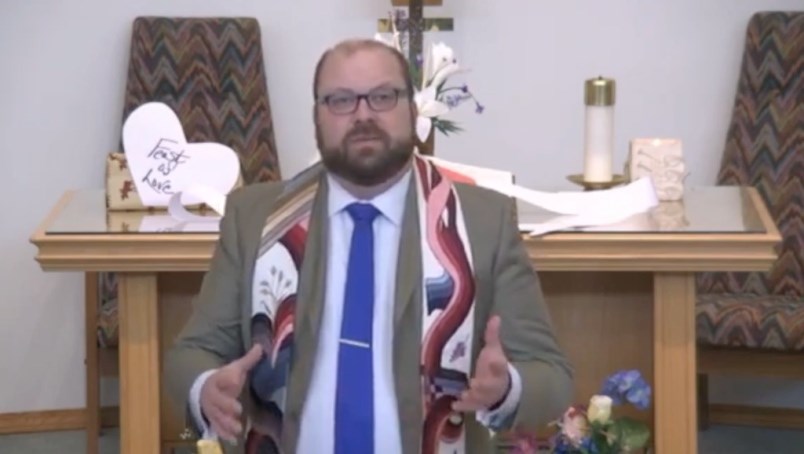New circuit-breaker measures put in place by the provincial health office Friday to curb the spread of COVID-19 kept churches empty Sunday with live attendance at worship services now banned in northern B.C.
Rev. Bob Fillier, the pastor at Trinity United Church in Prince George, said while he sympathizes with parishioners who will have to turn to virtual church services at least until Nov. 19, with Northern Health medical facilities struggling under the crush of COVID cases since the fourth wave of the pandemic took hold in late August he says something had to be done.
“I think most folks who are paying attention to the change in numbers and what was happening, it’s hard to say you’re surprised when they came out with new restrictions,” said Fillier. “I’m a little surprised they said no on-site worship at all instead of just greatly reduced numbers or that we didn’t go back to a maximum of 50 people or something like that.
“We have a number of people in our congregation who work in health care or who have family in health care and they’re done. They’re burnt out trying to keep up, so something a little more drastic makes a lot of sense.”
There were 184 new cases of COVID reported in the Northern Health region on Friday. All but four of the 15 local health areas in northern B.C. have for weeks reported a high number of COVID cases (averaging more than 20 cases per day per 100,000 population), and the numbers are especially high in the Prince George, Peace River North, Peace River South, Quesnel, Nechako and Smithers areas. The Delta variant of the virus was being blamed for the death Thursday of a Northern Health patient in their 20s and earlier in the week COVID also claimed the life of a northern B.C. patient in their 30s.
The order which took effect Friday applies to all of the northern half of the province except the local health areas west of Kitwanga, including Terrace, Kitimat, Haida Gwaii, Prince Rupert, Stikine, Telegraph, and Nisga'a. It will be reviewed by the provincial health office prior to Nov. 19. Fillier is praying the infection rates will drop sufficiently enough to end the ban on live church services by Sunday, Nov. 22, the start of the Christian church year.
“The hope is we will be back on-site again able to do stuff through the four Sundays of Advent leading up to Christmas and then the two Sundays after Christmas,” he said.
Churches in B.C. reopened for full in-person services in late-May, after 14 months of being closed entirely and later limited to congregations on no more than 50 people. The lifting of restrictions during the summer allowed funerals and other life events to proceed without restrictions on the number of attendees and that allowed faith leaders to perform services that were booked months in advance. Those funeral services are now on hold.
Before the first pandemic lockdown happened in March 2020, some churches, including Trinity United, were already livestreaming worship services in combination with live sermons. Even though the restrictions were lifted during the summer, as a majority of the population was immunized, Fillier said there were still many church-goers who did not feel comfortable about the idea of attending live services.
“It’s been a slow build,” Fillier said. “I think lots of folks were saying, ‘As soon as the doors open, I’m going to be back,’ and that hasn’t been our experience. It hasn’t been the experience of ay of my colleagues across the country. What we’ve noticed when things relaxed is we were getting 20 to 30 per cent of our pre-COVID attendance, and that had slowly increased over the course of the fall and by the time we hit Thanksgiving we were closer to 50 per cent of our attendance.
“The neat part for us is our on-site attendance is a small fraction of our digital attendance. (The church’s online reach) is somewhere between 375 and 400 devices a week. We can’t tell how many people but we can count how many devices and in lots of cases that’s families.”
Trinity United’s digital sermons are archived and are available for download on YouTube, Facebook or other platforms for people to view at any time. Fillier has regular viewers in Canada, the U.S., Central America, Europe and the Philippines. He provides regular workshops on Zoom to help other churches across the country work out the bugs of livestreaming.
“We were broadcasting before the pandemic but I don’t think many people knew about it and not a lot of folks went online looking for some kind of worship experience,” said Fillier. “The pandemic hits and you don’t have a choice and we were ready to go. March 15, 2020 was our last on-site worship service and a week later on the 22nd of March we were completely digital. We didn’t miss a beat.”
For as long as people have been allowed back, Fillier has enforced a requirement for masks and hand sanitizing and has tried to keep people separated in his church as much distance as possible. In events where there was a higher risk of spreading the virus, such as choir practice or monthly soup kitchen meals at St. Vincent de Paul drop-in centre, all attendees were required to show proof of vaccination.
Fillier said within six weeks of the start of the pandemic, church leaders were granted the opportunity to participate in conference calls that involve provincial health officer Dr. Bonnie Henty and Health Minister Adrian Dix and that has continued every two months for the past year-and-a-half.
“It’s pretty amazing when you think about the approach some other provinces have taken,” said Fillier. “The fact we’re given that kind of dedicated time to be consulted and ask our questions as faith leaders is an absolute hats-off to our provincial government.”



